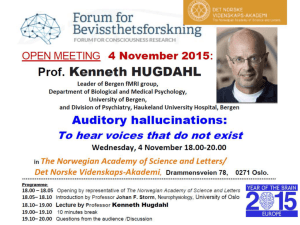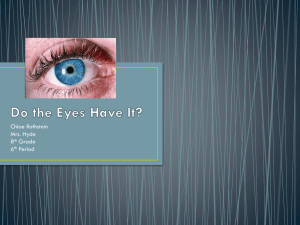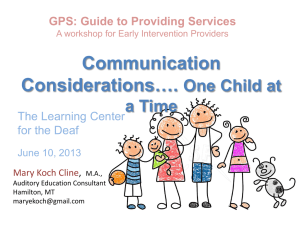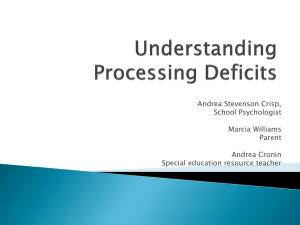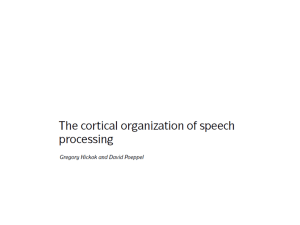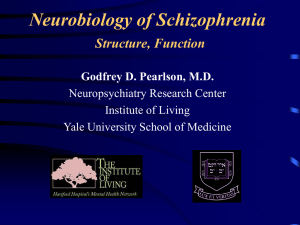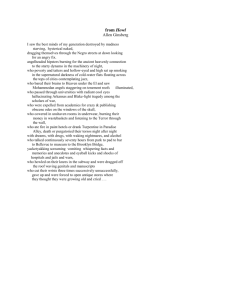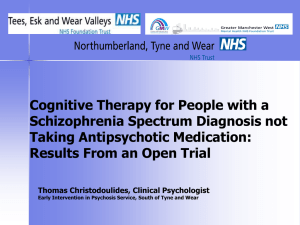Keynote: Kenneth Hughdal - 3rd Bergen International Conference
advertisement
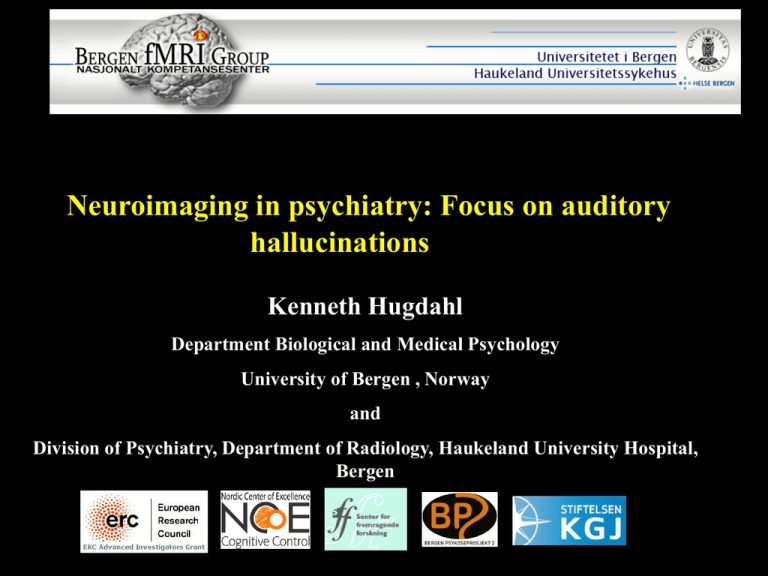
Neuroimaging in psychiatry: Focus on auditory hallucinations Kenneth Hugdahl Department Biological and Medical Psychology University of Bergen , Norway and Division of Psychiatry, Department of Radiology, Haukeland University Hospital, Bergen Schizophrenia • Heterogenous disorder – multitude of sub-classifications and symptoms • Diagnosis is descriptive and functional 295.90 F20.9 • Underlying mechanism(s) not known • No biomarkers or predictive models identified • Problem predicting treatment effects - leads to a "trial-anderror" approach X ERC Advanced Grant Project "Hearing Voices" - From cognition to brain systems • Focus on the symptom phenotype rather than the diagnosis. phenotype, «Phenotype constraining approach» • Auditory hallucinations are the most characteristic symptom in schizophrenia, it "defines" a psychosis • heterogeneity in a symptom can be quantified, heterogeneity in a diagnosis cannot • easier to focus research questions and hypotheses • easier to translate between levels of explanation • (easier to follow the literature) Three characteristic dimensions: • Perceptual dimension ("hearing a voice") • Cognitive dimension ("cannot control the voice") • Emotional dimension ("the voice is evil") The content of hallucinations Perceptual • «The voices not only speak to the patient, but they pass electricity through the body, beat him, paralyze him, take his thoughts away… » Cognitive Emotional • «Threats or curses form the main and most common content of the «voices». • «Day and night they come from everywhere, from the walls, from above and below, from the cellar and the roof, from heaven and from hell, from near and far…» Eugene Bleuler, Dementia Praecox, or The Group of Schizophrenia, Monograph 1911 Perceptual dimension - Auditory hallucinations would interfere with the processing of an external sound /ba/ /pa/ Correlating dichotic listening performance and PANSS P3 symptom scores ...should be a negative correlation between REA and PANSS N = 160, data from Norway, Turkey, USA r = -.304* r = -.135 Hugdahl, Løberg, Kompus et al. Schizophrenia Research (2012) r = .061 r = .026 Meta-analysis of difference in REA between Schizophrenia patients and Healthy controls 21 studies, N = 700 patients and 700 controls Patients vs. Controls Hallucinating patients. vs. Controls Ocklenburg, Westerhausen, Hirnstein et al., JINS, 2013 Functional imaging data: State effects Meta-analysis of PET and fMRIstudies "...we were fortunate to be able to study the interesting and rare case of a woman with schizophrenia who experienced continuous AVH..." K. Kompus, R. Westerhausen, K. Hugdahl Neuropsychologia (2011) "AVHs were associated with increased metabolic activity in the left primary auditory cortex ..." (Bentaleb et al., 2002, Abstract, p. 110) N = 103 ...but is this the same area(s) that are activated in healthy individuals in the presence of an external spech sound? Neuronal activation in hallucinating patients in the absence of an external speech sound N = 103 Kompus, Westerhausen, Hugdahl, Neuropsychologia (2011) Neuronal activation in healthy subjects in the presence of an external speech sound N = 12 van den Noort, Specht, Rimol,, et al., Neuroimage (2008) ...that lead to a "paradoxical" finding - the activation is reduced or disappears... Auditory cortex activation in the absence of a speech signal (state effect) Auditory cortex activation in the presence of a speech signal (trait • effect) The neurons seem to be "refractory" and the perceptual system is "shut down" during AHs... "Hallucinations "The auditory lowered the …or could be an N100 hallucinatory amplitudes state ... is attentional bias effect presumably associated due with to a reduced towards the «voice» which left reduced temporal activity in prevents the recognition of responsivity...competition temporal cortical regions an external stimulus, the cognitive system isthose "shutthat between that overlap auditory withstimuli down"… and normally hallucinations process external for physiological speech, possibly resources." because of • …or could be a signal(Hubl competition et al., 2007, for common Abstract, gating, rather than signalp.neurophysiological 57) processing effect, aberrant resources". inhibition of(Woodruff noise, theet al., 1997, Abstr, p. 1676) sub-cortical system is • "shut down"... N = 103 N = 204 Kompus, Westerhausen, Hugdahl, Neuropsychologia, 2011 • In all instances, AHs interfere with processing of an external sound ...but do patients really have problems with auditory and speech percption? • Pitch perception deficits for basic auditory stimuli, failure of MMN change detection (Javitt et al., 2000; Ahveninen et al., 2006; Fischer et al., 2011) • Impaired recognition of familiar voices (Zang et al., 2008) • Impaired recall of previously presented voices (Waters & Badcock, 2009) • Impaired ability to analyze speaker identity. (Chabra et al., 2012) • Hallucinating patients are impaired in voice identity recognition (Alba-Ferrara et al., 2012) • Hallucinators performed worse than non-hallucinators and controls for pitch discrimination of unmodulated tones and auditory streaming (MacLachlan et al., 2013) ? Hallucinating patients Non-Hallucinating patients Is there an underlying structural asymmetry that would strengthen the functional data? "Severity of AVHs was significantly associated with GMV reductions in the left and marginally with the right STG, including Heschl’s gyrus” /Meta-analysis by Modinos, Costafreda, van Tol,.McGuire, Aleman, Allen., Cortex, 2013, Abstract/ see also van Tol et al., 2013 G. Neckelmann, K. Specht, L. Ersland, K. Hugdahl et al. Int J Neuroscience, 2006 The Model Hypo-activated Topdown system Hyper-activated Bottom-up system Hugdahl, Løberg, Nygård, Frontiers in Neuroscience, 2009 Clinical implication Is it possible to selectively train attention focus away from the "voices" and towards the outer world, and at the same time increase cognitive control and executive function? In other words, hyperexcitate the top-down system! ...if imaging data explains the cognitive data, what explains the imaging data? Levels of Explanation • Cultural/Social Norms, beliefs, attitudes Levels of Explanation • Clinical Symptoms/Syndromes/Diagnoses •√ Cognitive Perception, Attention, Executive, Language •√ Brain imaging Neuronal systems and networks •√ Cellular Synapses and neurotransmitters • Molecular Genes, DNA, proteins AVHs seem to be excitatory phenomena, thus a first hint would be to search for an excitatory transmitter in the key regions in the brain The healthy indivdiual 1. Cortical Glu is synthesized from astroglia Gln 2. Release of Glu is balanced by GABA release 3. Striatal DA release is controlled by Glu/GABA Neurochemistry of auditory hallucinations The schizophrenia patient 1. Glu hypo-activity in schizophrenia leaves DAreceptors uninhibited, causing positive symptoms 2. Antipsychotic medication reduces DAlevels Thus, a first question is whether there is increased Glu levels in the hallucinating brain, and particularly in temporal (and frontal) areas? The hallucinating patient 1. Cortical Glu is not balanced because of GABA dysfunction 2. Glu hyper-activity initiates AH 3. AH not inhibited by DAantagonistic antipsychotic medication, beacuse AHs are Glu-mediated (Risperidone/Clozapine example) MR Spectroscopy (MRS) Frontal lobe MRS voxel Temporal lobe MRS voxel Cre NAA Cre Chol Glu,Gln (Glx) (GABA) Cln (Glx) TypicalGlu, 3TGlnMRS (GABA) spectrum (NAA peak truncated) NAA (truncated) p < .05 n.s. Hugdahl, Nygård, Løberg et al., in revision August 2014 p < .05 n.s. How specific is the correlation with the AVH symptom and Glu across the range of PANSS symptoms? Red correlations are significant at p < .05, Spearman's r Emotional dimension - attempt at quantification Use BAVQ scores to investigate if high PANSS score on P3 (AH) item goes together with negative or positive AH content (N = 54). Is this specific for AH? Outstanding questions: • Why are the "voices" predominantly negative, where does the emotional aspect come from? • What happens in the brain the last seconds before a patients wxpreineces "hearing a voice", the last seconds before the "voices" goes away? • What is it with "voices" that makes them appear both in clinical and non-clinical contexts, where is the "bridge"? • Is there a genetic predisposition "deep down"? The SFF/ERC AH Team IBMP/Haukeland team Rene Westerhausen, PhD, Senior Researcher Kristiina Kompus, PhD, Postdoc Marco Hirnstein, PhD, Postdoc Susanne Passow, PhD, Postdoc Merethe Nygård, PhD-student Liv E. Falkenberg, PhD-student Josef Bless, PhD-student Alex Craven, MS. Research technician, Maiken Brix, MD, Radiology Lars Ersland, PhD, MR-Physics Galyna Kovalchuk, MS, Research technician Sandviken-team Erik Johnsen, M.D., Ph.D., Psychiatry Rune Kroken, M.D., Ph.D. Psychiatry Jan Øystein Berle, M.D. Ph.D. Psychiatry Else-Marie Løberg, Ph.D., Clin. Psychologist Jill-Kristin Bjarke, Psychiatric Nurse, Hugo Jørgensen, Prof. emeritus, Psychiatry (consultant)
